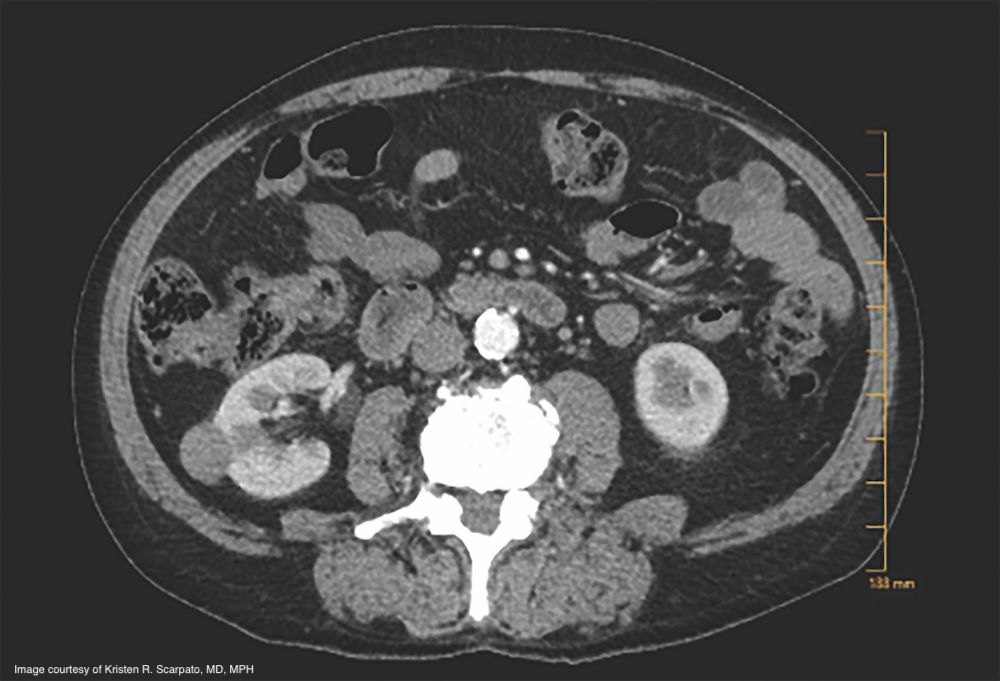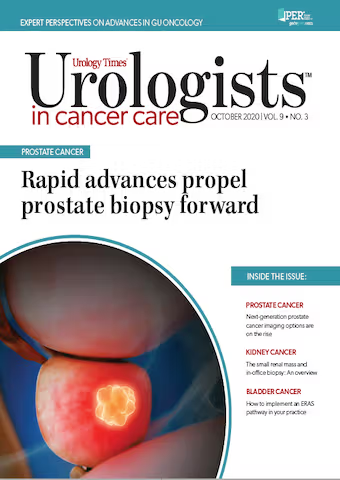Publication
Article
Urology Times Urologists in Cancer Care
The small renal mass and in-office biopsy: An overview
Renal mass biopsy should be used for patients in whom results would impact management decisions.
For this “Case of the Month” report, Raoul S. Concepcion, MD, FACS, interviews Kristen R. Scarpato, MD, MPH, regarding the usage of renal mass biopsy (RMB) for small renal masses, touching on topics including how to determine the need for an RMB, contraindications to RMB, and how she performs the procedure. Concepcion is chief clinical urologist officer, Integra Connect, West Palm Beach, Florida, and clinical associate professor of urology, Vanderbilt University School of Medicine, Nashville, Tennessee. Scarpato is assistant professor of urology at Vanderbilt University Medical Center, Nashville, Tennessee.
The Case
66 y.o. African American male referred for an incidentally discovered solid right renal mass, 2.7 cm, in a work up for back pain. Pre/post contrast 15 HU—> 48 HU. No evidence of fatty attenuation.
PMH: (+) HTN, NIDDM, Atrial Fibrillation, Obesity
PE: 5’9”, BMI: 40
Lab: UA: Clear BUN/Creat: 31 /1.7 mg/dl
Dr Scarpato, this is a scenario we as urologists encounter quite frequently in our everyday practice, the incidentaloma small renal mass (SRM). Would you walk through with us please what is your working definition of a SRM, and what radiographic and clinical factors do you take into account as you are trying to determine the need for a renal mass biopsy (RMB)?
Yes, this is a common scenario in urology clinic, which has coincided with the rise in abdominal cross-sectional imaging. A small renal mass typically refers to growth on the kidney measuring less than 4 cm (T1a),1 and at many centers refers to incidentally detected masses less than 3 cm. The 3-cm cutoff originated in the VHL (von Hippel-Lindau syndrome) literature, which suggests that malignant tumors less than 3 cm have a very low likelihood of metastatic spread. Similarly, data indicate that patients with sporadic tumors less than 3 cm also have a low rate of progression and metastasis.2,3 When faced with this scenario, it is important to first consider the patient. What is his overall health, and does he have significant cardiac, pulmonary, renal, or other conditions? Does he have risk factors for RCC (renal cell carcinoma) or history of another primary malignancy that may have metastasized? In this patient, his diabetes and renal failure are important considerations when contemplating future renal mass intervention. When considering the mass, it is important to consider tumor location (central vs. peripheral, anterior vs. posterior, medial vs. lateral), endophytic vs. exophytic, size, solid versus cystic consistency, degree of enhancement and vascularity, as well as any significant necrosis. If prior imaging is available, it is helpful to assess growth kinetics over time.
In your opinion, are there any absolute or relative contraindications to RMB?
When counseling the patient, you need to consider the anatomic complexity of the lesion and the implications of the biopsy result on further management. In some patients, it may not be feasible to perform the biopsy due to truncal obesity and significant skin-to-tumor distance. Similarly, in the case of cystic lesions or solid masses in a challenging location, such as those that are medial and upper pole or perihilar, RMB may be relatively contraindicated.
Also, if results are unlikely to change your management plan, I would recommend against biopsy. Although not necessarily a contraindication, it is important to consider patients requiring anticoagulation for periprocedural management if biopsy is being pursued. And finally, historically, tumor seeding was felt to be a contraindication to the procedure. However, this is more of a theoretical risk as tumor seeding of the biopsy tract has not been significantly demonstrated in practice.
Do you differentiate between a solid SRM versus a Bosniak II, III, or IV in your recommendations for RMB?
Yes. This is important when considering RMB. Cystic masses are more challenging to biopsy. For cystic renal masses with higher malignant potential, those that are Bosniak (classification system) III or IV, biopsy is really only feasible if there is a solid component to target. Even then, there is a risk of a non-diagnostic biopsy result, sampling error, or tumor spillage. Generally, when cystic lesions are suspicious for malignancy, we proceed to surgery without attempted biopsy.
At your institution, when you feel a RMB is indicated, are you personally performing the procedure in an office setting or referring these patients to the interventional radiologist (IR) for percutaneous RMB?
At our institution, all RMB for SRMs concerning for cancer are referred to our interventional radiology colleagues. In the IR suite, the interventionalists provide sedation and local anesthesia unless there is a contraindication in which case an anesthesiologist would be involved.
That said, there are certainly urologists who routinely and successfully perform RMB in the office.4 As a specialty, we are facile with ultrasound and the evolution of ultrasound biopsy platforms makes RMB more accessible for us. It is reasonable for urologists who feel comfortable to offer RMB in the office to appropriately selected candidates, particularly those patients with posterior, subcostal lesions.
Obviously depending on site of service, are these best directed with ultrasound, CT, or MRI guidance?
As with most procedures, it comes down to the comfort and experience of the proceduralist and institution. He or she should perform the biopsy in the manner that is most appropriate for him or her. I don’t think one modality has been shown to be superior to the other. Most commonly RMB is performed with CT or ultrasound guidance. Ultrasound may be advantageous for characterization of some lesions, particularly endophytic renal masses, and it avoids contrast exposure, while perhaps being more convenient and cost-effective.
Would you please walk us through operationally the preferred technique you have adopted?
At our institution, patients are most often given sedation and local anesthesia. We are routinely taking core biopsies rather than FNAs (fine needle aspirations) because of the higher diagnostic yield. FNA is often inadequate unless biopsies are performed in conjunction with a cytopathologist on site who can assess the samples immediately. The number of cores taken depends on the quality of the cores, as assessed by the proceduralist. Often, we see 3 to 5 cores per sample. Following the procedure, patients are observed as an outpatient in the radiology suite with close attention to vital signs including pulse oximetry. Some centers may check urinalysis or renal ultrasound prior to discharge5. For complex patients, an overnight stay may be required for additional monitoring.
What are the major complications that have been reported with RMB?
Fortunately, major complications are rare. The literature indicates about a 2% risk of complication overall, with major complications occurring less than 1% of the time.6 Risks include hematoma, pain, infection, with more significant complications of pseudoaneurysm, pneumothorax, and the one we probably all think of first—bleeding. However, even in the face of anticoagulation or antiplatelet medications, the bleeding risk is still quite low. We can’t forget about the risk of nondiagnostic biopsy either, which can occur in up to 15% of RMBs.
Besides histopathology, do you typically send the tissue for any other type of biomarker/genomic testing?
At this point, we are utilizing RMB histopathology results for distinguishing cancer vs noncancer and not sending this tissue for biomarker or genomic testing, although that may be the future state, particularly as we learn more about the genomics of RCC. Recent data highlight the impact of determining histologic subtype at the time of RMB, which may have implications on progression.7 We are practicing in the era of precision medicine and personalized care. We are certainly seeing genomics in management of other urologic cancers, like prostate, and in some cases of advanced RCC. However, even for advanced RCC there is a lack of guidance or consensus about the use of genomic testing given the absence of definitive literature.
In your experience, if a patient undergoes RMB and ultimately proceeds to surgical extirpation, have you found the procedure, whether it be open or minimally invasive, to be more difficult due to the inflammation? If so, do you prefer to wait a set period of time before taking the patient to the operating room in hopes that the inflammation will subside?
I am not aware of any literature demonstrating that renal mass biopsy prevents future partial or radical nephrectomy or that it is associated with a higher complication rate. Generally, I would wait a minimum of 4 to 6 weeks from the time of biopsy to allow the patient time to heal. Anecdotally, if a patient develops a bleed with perinephric hematoma following biopsy, the tissue planes can be distorted and the surgery more challenging. In those patients, I may wait longer—months if possible—before proceeding with surgical extirpation.
For our audience, what would you say are the key take-home messages when contemplating percutaneous biopsy for patients with a SRM?
RMB is an important tool in the management of SRMs and should be utilized for patients in whom the results would impact management decisions, typically not the young and healthy or the old and frail. RMB should be performed following shared decision-making.
Figure. Incidentally detected small renal mass, right kidney, in an diabetic, hypertensive male with mild renal dysfunction considering his management options. Source: Kristen R. Scarpato, MD, MPH

RMB may be utilized for differentiating benign from malignant tumors but less readily characterizes low grade from high grade. No biomarker or genomic testing is recommended following biopsy of SRMs, although with advancing technology and increasing knowledge of RCC, this is likely on the near horizon.
RMB can be safely performed in the interventional radiology suite or in the urologist’s office depending on physician comfort and experience and SRM characteristics.
Both CT and ultrasound guidance are effective in RMB, with the benefits of ultrasound being potentially improved characterization of endophytic lesions, more readily accessible technology, and cost savings.
References
1. Campbell S, Uzzo RG, Allaf ME, et al. Renal mass and localized renal cancer: AUA guideline. J Urol. 2017;198(3):520–529. doi:10.1016/j.juro.2017.04.100
2. Crispen PL, Viterbo R, Boorjian S, et al. Natural history, growth kinetics, and outcomes of untreated clinically localized renal tumors under active surveillance. Cancer. 2009;115(13);2844-2852. doi:10.1002/cncr.24338
3. Frank I, Blute ML, Cheville JC, et al. Solid renal tumors: an analysis of pathological features related to tumor size.J Urol. 2003;170(6 Pt 1):2217-2220. doi:10.1097/01.ju.0000095475.12515.5e
4. Dave CN, Seifman B, Chennamsetty A, et al. Office-based ultrasound-guided renal core biopsy is safe and efficacious in the management of small renal masses. Urology. 2017;102:26–30. doi:10.1016/j.urology.2016.12.026
5. Dutta R, Okhunov Z, Vernez SL, et al. Cost comparisons between different techniques of percutaneous renal biopsy for small renal masses. J Endourol. 2016;30(suppl 1):S28-33. doi:10.1089/end.2016.0015
6. Posielski NM, Bui A, Wells SA, et al. Risk factors for complications and nondiagnostic results following 1,155 consecutive percutaneous core renal mass biopsies.J Urol. 2019;201(6):1080-1087. doi:10.1097/JU.0000000000000113
7. Finelli A, Cheung DC, Al-Matar A, et al. Small renal mass surveillance: histology-specific growth rates in a biopsy characterized cohort. Eur Urol. 2020;78(3):460-467. doi:10.1016/j.eururo.2020.06.053
Newsletter
Stay current with the latest urology news and practice-changing insights — sign up now for the essential updates every urologist needs.






















